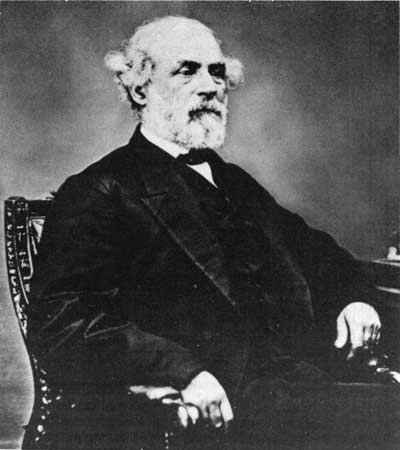|
CUSTIS-LEE MANSION The Robert E. Lee Memorial |
 |

Robert E. Lee in 1869 when President of Washington
College, Lexington, Va.
From the Brady photograph, U.S. Army
Signal Corps.
Arlington from 1865 to the Present
LEE'S INFLUENCE HELPS TO RESTORE THE SOUTH AFTER THE WAR. The splendid leadership which Lee had given his people during the war did not cease at Appomattox. As president of Washington College (afterwards Washington and Lee University), he devoted himself to restoring the South culturally, economically, and politically. Magnanimous in peace as in war, he urged his countrymen to forswear hatred and make the best of their situation. By his advice and example he did much to bring about the true restoration of the Union, not by force, but by the immeasurably stronger bonds of reconciliation and a common loyalty.
For a time General Lee hoped to regain possession of Arlington for his wife, but he died in 1870 without having recovered it. Mrs. Lee died 3 years later, and her son Custis then took legal action to obtain his inheritance. In 1882, the case was finally decided in his favor by the Supreme Court of the United States, but since thousands of soldiers had been buried at Arlington, Custis Lee accepted the offer of the Government to buy the property for $150,000.
ARLINGTON BECOMES FAMOUS AS THE FORMER HOME OF GENERAL LEE. Originally "Arlington House" had been famous for its associations with George Washington; but after the Civil War it became even more widely known as the former home of General Lee. Though its rooms were empty, thousands from all over the country came to see it each year because of the universal admiration for its former master. It was in response to this sentiment that Representative Louis C. Cramton, of Michigan, sponsored the legislation passed by Congress in 1925 which authorized the restoration of the mansion as a national memorial.
RESTORATION OF THE MANSION. The project of restoring and re furnishing the mansion was begun by the War Department in 1928. Structural changes made since 1861 were removed and the house refurnished as nearly as possible as when occupied by the Lee and Custis families. The original furnishings having long since been scattered or lost, few could be returned to their old setting, but copies were made of furniture and portraits known to have been at Arlington and pieces appropriate to the period procured. By 1933, when the mansion was transferred to the National Park Service of the Department of the Interior, the major portion of the work had been finished. However, the work of restoring the mansion to its original condition is a continuing process, as structural changes based on historical research are made and more of the original furnishings are identified and acquired.

|
|
Last Modified: Mon, Dec 2 2002 10:00:00 am PDT |


